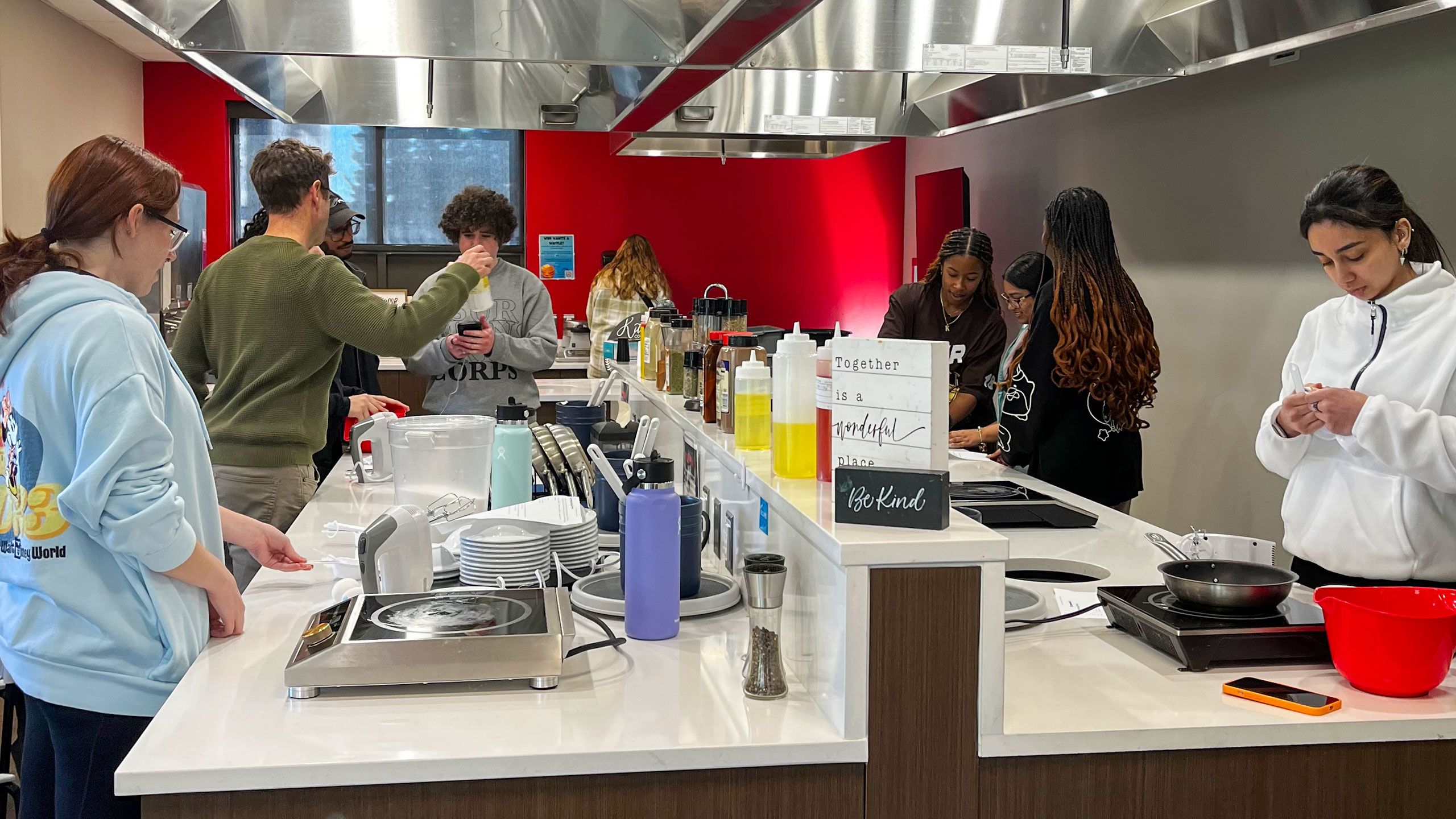From Seasoning to Soufflé:
The Science of Cooking
Rutgers–Camden professor demonstrates introductory principles of physics in university test kitchen

On a recent spring afternoon in the Rutgers University–Camden teaching kitchen, students learned about phase changes using egg whites, sugar, and cream of tartar. Hunter King, assistant professor of physics, challenged the students to consider how these ingredients would transform from a liquid and two solids into light, fluffy foam.
“When you whip the egg whites, you denature the proteins with agitation; in other words, you break apart the protein molecules of the egg whites while adding air bubbles, a gas,” said King. He added that sugar is needed to keep the bubbles stable, and cream of tartar, which is acidic, keeps the sugar from crystallizing.

Student teams proudly display the results of the “meringue challenge,” a lesson in the Physics of Cooking class at Rutgers–Camden
Student teams proudly display the results of the “meringue challenge,” a lesson in the Physics of Cooking class at Rutgers–Camden
The “meringue challenge” is just one way King engages his class. The Physics of Cooking, offered to students in the Honors College, is an introductory exploration of science through the lens of food and the art of cooking. Through simple ingredients and techniques, students learn the basic elements of material science.
"I use the kitchen and cooking to introduce concepts students may think they have no interest in," King said. “They may not be drawn to physics, but everyone is interested in food." He uses food's common appeal to challenge students to become more curious about the world around them and notice how they interact with raw materials, especially the ones in their refrigerators.
The class was inspired by a conversation King had with a student a few years ago about the parallels between cooking and polymer physics, the study of the interaction of large molecules linked together chemically.
“Cooking is a very useful window into polymer physics because when you're cooking, you are dealing with basic polymeric materials, like proteins and starches, and how they interact when you combine materials or introduce a temperature change,” King said.
For Kimberly Lugo, a junior in the Rutgers School of Nursing–Camden, the opportunity to learn physics through this novel and unexpected approach was exactly what drew her to enroll in the class.
“Every class session surprises me with the underlying reason behind various cooking reactions,” Lugo said. “Before this class, I didn’t consider the mechanisms behind cooking or the science behind it. This class has helped me have a scientific understanding in a way I wouldn't have otherwise.”
King hopes staple ingredients like sugar and salt, and basic actions like heating and mixing, inspire a profound shift in students’ thinking as they progress through the course material. From understanding how gluten networks are created from the simple act of kneading flour and water, to making mayonnaise, a solid, from the three liquids of egg yolk, oil, and vinegar, the goal is to connect with science in a practical and meaningful way.
“There is value in recognizing the limitations of how one might normally think,” King said. “I hope that by stepping beyond their existing knowledge, my students can gain a more rigorous, scientific approach to interacting with the world.”

Students learn the fundamentals of polymer physics through cooking
Students learn the fundamentals of polymer physics through cooking

King explains the phase transition that occurs during the process of making meringue
King explains the phase transition that occurs during the process of making meringue

One student team was challenged to make vegan meringue with aquafaba, or chickpea water, which mimics the role egg whites play in non-vegan meringue
One student team was challenged to make vegan meringue with aquafaba, or chickpea water, which mimics the role egg whites play in non-vegan meringue

Students examine an ongoing experiment on crystallization
Students examine an ongoing experiment on crystallization

Design: Douglas Shelton
